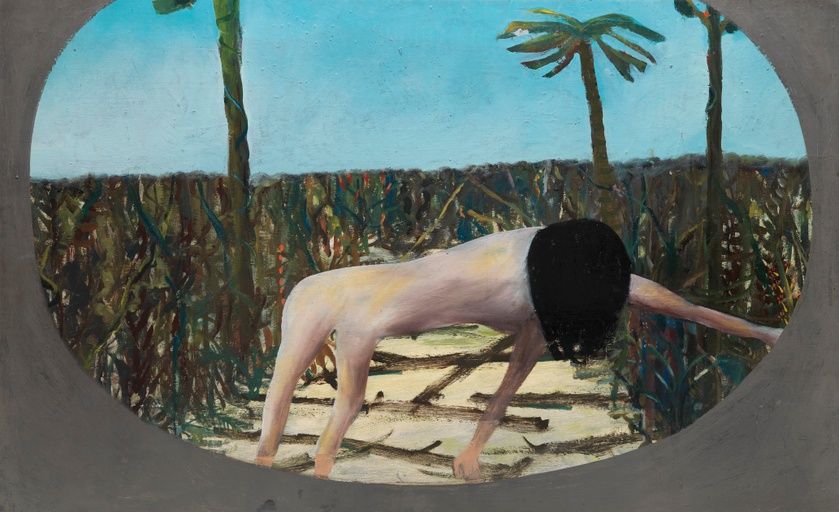

Mrs Fraser, 1947
Sidney Nolan, Mrs Fraser, 1947, Ripolin enamel on hardboard, 66.2 x 107 cm. Purchased 1995 with a special allocation from the Queensland Government. Celebrating the Queensland Art Gallery's Centenary 1895–1995. Collection: Queensland Art Gallery. © Sidney Nolan Trust
Anne Carter is a paintings conservator who has worked at Queensland Art Gallery Ι Gallery of Modern Art (QAGOMA) since 2000. Her interests lie in the conservation of contemporary paintings and she has published on the materials of Ian Fairweather and Charles Blackman. With thanks to Paula Dredge, Gillian Osmond and David Rainey.
“Sidney Nolan spent October of 1947 on K’gari (Fraser Island), a sand island off the coast of Queensland, where he produced a number of large paintings. Mrs Fraser (then titled Woongoolbver Creek) was one of twelve works exhibited at the Moreton Galleries in Brisbane in February 1948. It was reworked and re-exhibited as Mrs Fraser in 1957 in Nolan’s Whitechapel Retrospective in London.
As a physical artwork, Mrs Fraser is intriguing in its technique and materials. Nolan merged layers of glossy oil-based Ripolin enamel (brought with him in jars from Melbourne) on Masonite salvaged from old island army huts. This work is remarkable for both its paint stability and the number of revisions. It was unusual for Nolan to rework his paintings, but he tended to this particular painting over a number of years, keeping it all his life. Among his various revisions he reworked horizon lines to open up a sky over the entangled forest, added a grey oval border and trimmed 12cm from its top.
Wanggoolba Creek (as it is now spelled) is a crystal-clear freshwater creek running through piccabeen palm forest near the centre of the island. Darkened palm fronds litter the creek bed, and October brings springtime flushes of new red growth to the forest green. Nolan wrote that the water of the creek was so clear that it was almost invisible. His faithful capturing of the local environment confirms Nolan’s genius as a landscape painter — seventy years later the creek remains true to his depiction. This is a legacy of environmentalists in the 1970s and 1980s, who fought to end sand mining and were successful in having most of the island designated a National Park with World Heritage status. Poet and activist Judith Wright, a friend of Nolan’s, argued in the 1975 Fraser Island Environmental Enquiry not only for the island’s protection on environmental grounds, but also on cultural grounds: the island was ‘hallowed’ by its association with Nolan’s works of art.
Nolan’s travels to Queensland in 1947 marked a break from his life at Heide with John and Sunday Reed. His visit to K’gari was an experience of great significance for the artist, and he returned to his memories of this time in his later works. The identifiable location of the painting merges with an imagined depiction of the shipwrecked Mrs Fraser - drinking from the creek - and we continue to postulate about how Nolan’s portrait of Mrs Fraser is intermingled with his feelings of heartbreak from Sunday Reed at this time.
The painting also reminds us of Australia’s violent history of colonisation. ‘Sidney Nolan . . . imagined and mythologised the experience of Scottish woman Eliza Anne Fraser, who was shipwrecked off the coast of Queensland in 1836. Accounts of Mrs Fraser’s experience, steeped in colonial assumptions and elevated to the status of legend through multiple and contradictory tellings, effectively demonised the island’s inhabitants, and the stories have since been contested.’1
The local Butchulla people, who soothed Mrs Fraser’s sunburn and protected her during her weeks on the island, are said to have saved her from certain death but were themselves treated so poorly by the colonisers. In partial recognition of this injustice, the Great Sandy National Park was formally renamed K’gari in April 2017 — a return to its traditional name, meaning ‘paradise’.
Nolan has brought together his journey from Melbourne, the physical environment of K’gari and the historical story of Eliza Fraser, in a mastery of house paints and found material that is both powerful and immediate for the viewer, making Mrs Fraser a remarkable work from a significant period in the artist’s life.
Mrs Fraser is one of three paintings on the subject held at the Queensland Art Gallery Ι Gallery of Modern Art and on display in the Australian collection galleries.”